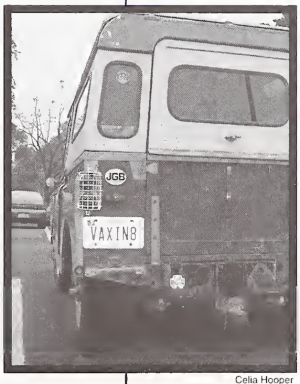A Shared 30th Anniversary

The NIH Catalyst is commemorating 30 years of publishing with a series of past coverage updates. In this issue, we highlight Women Scientists Advisors.
Women Scientists Advisors Celebrate 30 Years of Advocating for Equality
The NIH Catalyst shares both an anniversary and a vision with the Women Scientists Advisors (WSA).
In our first issue (February 1993, pages 4–5), Hynda Kleinman, now a retired section chief of National Institute of Dental and Craniofacial Research (NIDCR), reported findings from the 26-member Task Force on the Status of NIH Intramural Women Scientists, which she led. The task force was formed in November 1991 by then-NIH Director Bernadine Healy to identify both real and perceived impediments to NIH women scientists.
The task force reported that although women in postdoctoral positions had risen to a level equivalent to the percentage of women nationwide who were completing doctoral programs in the life sciences, women at NIH in scientific career and leadership positions were far below acceptable levels. In fact, women represented only 18% of tenured scientists and 4% of lab chiefs.
They recommended increased communication, appointment of a career-development coordinator, a tenure-track plan, equal pay, improved visibility, and a flexible family leave plan. In response, the scientific directors (SDs) “unanimously endorsed the appointment of a Woman Scientist Advisor for each Institute, Center, and Division.” And thus, WSA was born.
Fast forward to the September—October 2001 issue of the Catalyst (pages 2–3) and a guest editorial by Joan Schwartz titled “Ten Years and Counting: Have NIH Women Scientists Advanced Since the Task Force Report?” Modest improvements had been made.
- Salary corrections in 1994
- The Margaret Pittman Lecture Series was developed to ensure women scientists also had the opportunity to present NIH-wide scientific lectures. Pittman was the first woman laboratory chief at NIH.
- Tenure-track women scientists increased to 25% in 2001
- Women SDs increased from 0 to 4
- The number of women lab and branch chiefs increased from 4% to 10% after a concerted effort in 1994—1995
- But tenured women scientists remained constant at 18%
Schwartz, then an assistant director in the Office of Intramural Research who had served on the Director’s task force, reported two impediments to progress: 1) gender schema and 2) accumulation of advantage. Gender schema refers to gender biases, conscious or otherwise; accumulation of advantage, Schwartz explained, was a phenomenon at NIH that “suggests a small bias that favors men on the tenure track with more space, larger budgets, and higher salaries.”
|
*As of April 2023; **FY 2020 data is the latest reported for lab/branch chiefs.
Intramural scientists’ demographic information dating back to 2016 is available at https://oir.nih.gov.
Fast forward once more, this time 20 years, and the accumulation of (dis)advantage for women scientists in senior scientific roles unfortunately has remained nearly constant.
“The fact that these issues existed 30 years ago, and that we still have such a long way to go, I think, says a lot,” said Mary Kearney, WSA Chair and Senior Scientist at National Cancer Institute’s Center for Cancer Research.

CREDIT: NCI
Mary Kearney serves as WSA Chair and is a Senior Scientist at National Cancer Institute’s Center for Cancer Research.
Kearney pointed out that over the past 30 years, significant movements occurred in the United States that brought attention to the issues faced by women in the workplace, such as the Anita Hill hearings in 1991, which may have been the impetus to forming the original task force. Since that time, progress has coincided with similar events.
“I think there can be backlash, too,” Kearney added. “When women and underrepresented groups try to make change, it is oftentimes two steps forward and one step back. So, progress has been slow. Still, we can ride on the coattails of nationwide movements and try to continue to make progress.”
Kelly Ten Hagen, Senior Investigator at the NIDCR and past WSA Chair, expanding on what Kearney said, offered the example of salary adjustments.
“For reasons that we don’t completely understand there is this kind of creep that occurs as salary disparities reappear,” said Ten Hagen. “We see things that occurred 30 years ago, that were corrected, but now 30 years later, it is happening all over again. We need to get to the bottom of that.”
Progress continues to be made by WSA. Ten Hagen and WSA Executive Committee Member Julie Segre, Senior Investigator at the National Human Genome Research Institute, both served on the Advisory Committee to the Director Working Group on Changing the Culture to End Sexual Harassment; and Segre and Ten Hagen were joint recipients of the 2019 NIH EDI Award of the Year in recognition for efforts to help design and implement the NIH Anti-Harassment and Personal Relationships Policies and Workplace Climate and Harassment Survey.
“There was a lot of progress made in the development of policies against sexual harassment and other forms of harassment,” Ten Hagen said. “We are working on ensuring recommendations are being followed, making sure reporting systems work and harassment is being addressed. Of course, we want to try to continue to build on this to improve the climate and culture for everyone.”
With an eye to the future, Kearney and Ten Hagen said they are looking to improve transparency in leadership position searches, to extend their efforts for all diverse groups who have been historically marginalized, and to reimagine the “traditional scientific path” to extend and diversify opportunities.

CREDIT: NIDCR
Kelly Ten Hagen is the immediate past chair of WSA and is a Senior Investigator at NIDCR.
The WSA has spent 30 years transforming NIH, while trying to achieve such equality and equity.
“I think another thing that the WSA can do, alongside other committees, is to make recommendations for how women and minorities can be supported in leadership, be promoted into leadership, and be retained in leadership positions,” said Kearney. “Women and minorities leave leadership positions more commonly than white men because women and minorities often face other challenges in addition to the work. They might be dealing with microaggressions, blatant racism, and sexism. There are challenges there for which we have to provide more support, including administrative support.”
Ten Hagen agreed, adding that research shows that women are penalized for negotiating. “Negotiating can have negative repercussions for women and other underrepresented groups. But negotiating is part of almost any position. If this is the kind of general or societal bias that we face, it puts us at a very distinct disadvantage.”
“Women have contributed to our scientific knowledge and the biomedical research enterprise, but we also have been able to transform the landscape and make significant progress to try to level the playing field—with the caveat being that the playing field is still not level” Ten Hagen said, pointing out that women should not be solely responsible for trying to level the field.

CREDIT: WSA
WSA is celebrating 30 years of advocating for equity.
The WSA aims to continue to be a resource for the community—to ensure equity and support for women scientists. The WSA committee recommends NIH women scientists at all career levels reach out to their IC-based WSA representative if they have concerns. They want to understand the issues women are facing so that they can advocate for change.
The WSA has made significant progress over the past 30 years, but clearly there is much left to be done.
To learn more about WSA, visit the WSA website at https://sigs.nih.gov/wsa or attend one of the upcoming WSA 30th Anniversary Seminar Series events.
Remember when?
Celia Hooper reflected on her contributions to The NIH Catalyst during her tenure as Scientific Editor (1993—2006).
“My managing editors and I liked to reflect [on] some of the delightful, zanier aspects of life at NIH,” Hooper wrote in an email to the Catalyst. She shared some of her memorable contributions.

- “Write Right. Ya Gotta.”
(March—April 2000, page 4) - “NIH’s Vanity Plate”
(November—December 1997, page 1 and page 5, where you can read more about WSA’s Schwartz’s vanity plates, too) - A visit to the Rocky Mountain Laboratory
(September—October, 1998)
She “definitely recommends” we treat readers to a Rocky Mountain revisit. We definitely agree.
In our next issue, we will highlight former cartoonist Alex Dent and share a few scientific updates, too.
Want us to include your work or IC with a then-and-now highlight? Stroll through our archive repository at https://irp.nih.gov/catalyst/archived-issues for past coverage and then email us an update to catalyst@nih.gov and let us know how things have progressed over the years.
Join the conversation on Twitter with hashtag #NIHCatalyst30.
This page was last updated on Thursday, May 4, 2023
